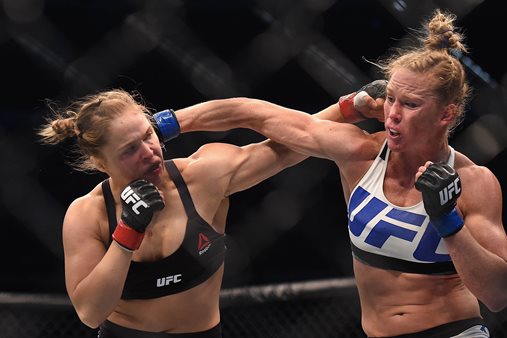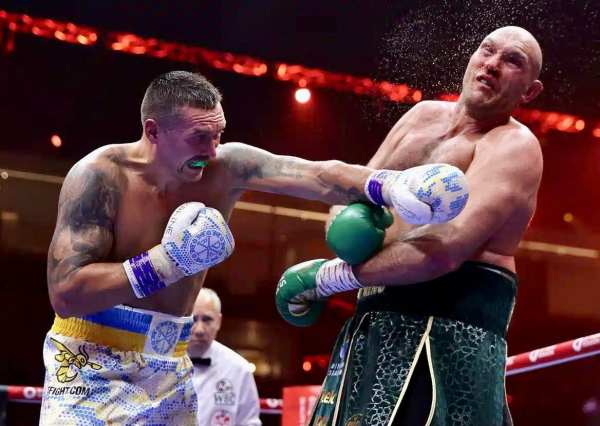
Bloody Elbow striking specialist Connor Ruebusch analyzes the peculiarities and limitations of Holly Holm’s boxing style ahead of her UFC 208 showdown with Germaine de Randamie.
/cdn0.vox-cdn.com/uploads/chorus_image/image/53161793/usa-today-9764997.0.jpg)
Over the course of my career as a fight analyst, I have gone away from my once intense focus on fighting technique. Of course, every week I write and/or talk about technique in one way or another, but there was a time when I made a habit of drawing lines in the sand: “This is the correct way to throw a punch,” “This is bad footwork,” “This is the only way to safely move your head,” and so on and so forth.
The reason I’ve softened on this front is that, in the end, technique is not everything. Durability, power, conditioning, desire, intelligence, luck–there are many, many factors which can enable a fighter to succeed, even become great, despite improper technique. And there are many different and equally valid interpretations of what “proper” technique looks like. I can point out that Mike Tyson’s style of head movement was dangerous and unsustainable till I’m blue in the face, but at the end of the day he’s still Mike Tyson.
Still, technique does matter. Jon Jones was already great in 2013, but when he learned to throw a stiff jab and keep his balance as he moved he got even better. Jose Aldo was a champion at 23, but he hadn’t perfected the head movement and boxing skill for which he is now known until well after his 26th birthday. And there are many, many accomplished fighters who continue to be held back by one or two very specific details.
Such is the case with Holly Holm.
I have addressed the issues with Holm’s boxing style in the past, but power is not the only thing inhibited by her stance and punching mechanics. Take a look at the way Holm holds herself.
This is Holm’s fundamental position, the stance to which she returns after every exchange, and from which she launches every attack. Note that her weight is oriented forward. The right foot is planted flat on the ground, while the left heel floats an inch above the canvas. Her upper body is also inclined forward, placing her head more or less directly above her right knee. In past pieces (and on the latest episode of Heavy Hands) I have pointed out that this position does not lend itself to a powerful left hand, Holm’s primary weapon, because there is no way to transfer meaningful weight from back to front and from left to right when most of that weight is already on the lead foot.
There is another issue with Holm’s stance, however, that was particularly unhelpful in her bout with Valentina Shevchenko, and which could prove to be an even bigger hurdle against the significantly larger and more powerful Germaine de Randamie at UFC 208.
The problem lies in how Holm’s stance forces her to cover distance. The UFC recently posted an infographic on Twitter which proudly declared that Holm lands 99 percent of her standing strikes, a claim so onerously untrue that, after a few well-deserved jabs from keen-eyed fans, the promotion quickly deleted the tweet. Even the least observant fight fan could point out that Holm whiffs on her punches all the time. In fact, for a former boxing champion her inaccuracy can be downright astounding. For example, Holm threw 211 significant strikes against Shevchenko, and landed only 54–a connect rate of just 25 percent.
Valentina Shevchenko’s skill could explain a portion of this figure, but in truth “The Bullet” was hardly forced to employ the full breadth of her defensive abilities. In fact, Shevchenko barely adapted or changed her approach in any way over the course of the fight. She landed between 13 and 21 punches in every single round, and kept Holm from landing more than 15 per round no matter how much Holly increased her output.
The reality is that, for an experienced striker such as Shevchenko, Holm’s punches are simply too easy to predict. To understand why, let’s take a quick trip back in time to visit 17th-century fencing master George Silver. From his treatise Paradoxes of Defence:
The true fights be these: whatsoever is done with the hand before the foot or feet is true fight. The false fights be these: whatsoever is done with the foot or feet before the hand, is false, because the hand is swifter than the foot, the foot or feet being a slower mover than the hand; the hand in that manner of fight is tied to the time of the foot or feet, and being tied thereto, hath lost his freedom, and is made thereby as slow in his motions as the foot or feet: and therefor that fight is false.
Even having modernized Silver’s language and spelling a bit, that paragraph is a little too archaic and long-winded to read well. So here is Silver’s gist: a strike thrown with only the arm is faster and significantly harder to predict than a strike which is tied to the movement of the feet. The reasoning is simple. The arm is small and light, and requires little energy or wind-up to move. The feet, on the other hand, bear the weight of the entire body. And because the body is so much larger than the arm, its movement is far more obvious to an opponent, and requires much more effort.
We can add to Silver’s paradigm the movement of the upper body. Leaning backwards and forwards at the hips is an effective way to close and create distance, and while the torso is slower than the hand, it is still faster than the feet.
This same principle applies to defense. The quickest way to defend a strike is to block, parry, or catch it, the speed of the defender’s hand being more or less equal to that of the attacker. Next there is head movement: the upper body is slower to move than the hands (although evasion, because it causes the opponent to miss entirely rather than making contact, has its own advantages). The slowest manner of defending a strike is to move the feet–stepping away or to the side–because, again, moving the feet means moving the whole of the body.
Thus we have what Silver would have called the three times. The time of the hand, the time of the body, and the time of the foot.
Of course, every fighter knows that damaging strikes are not thrown without the involvement of the entire body. George Silver placed a great deal of emphasis on speed over power, but the sharp edges and point of a sword are infinitely more dangerous than a balled fist, and so a fencer requires relatively little power to deliver a fatal wound. Mixed martial artists and boxers, however, must concern themselves more with the impact of their strikes. We know that power is generated from the ground, through the feet, and with the help of the hips and shoulders.
Even so, Silver’s advice was not to move only the hand, but simply to move the hand before the foot. Whether throwing an arm punch or a knockout blow, the order in which the parts of the body move matters: when a punch is initiated with the movement of the hand, it tends to be much more surprising.
You can try this out yourself with a little experiment–provided you have a friend who is willing to let you punch him in the chest a few times. Be gentle and wear cushy gloves, please. Safety first, now. Ready? Okay, try this: have a friend stand just outside of jabbing range, about one short step away from the end of your outstretched arm. Instruct him to step back when you throw a jab (at his chest, remember). His goal is to evade the punch.
First, try to step in before extending your arm. Provided your buddy has healthy human reflexes, he should be able to step away and avoid this shot with relative ease. His feet are probably about as fast as yours, so as you cover distance, he will create an equal amount of space. Stalemate.
Now reset, and jab again, only this time begin extending your hand before you take the necessary step forward. Your feet will not move any faster than before, but the hand will be much closer to the target before the rest of your body starts to close the gap. Because your hand is faster than your friend’s feet, you should be able to touch his chest well before he manages to retreat. That little head (or perhaps it should be hand) start is all you need.
Now take a look at Holm’s stance again, and see how it affects the way she closes distance to punch.
1. Holm stands in her usual position, outside of boxing range.
2. Before letting go a punch, Holm takes a long step forward.
3. She throws a straight left, but Shevchenko is already pulling away.
4. Holm follows by shifting–more foot movement–and comes into range for a right straight, but Shevchenko picks it off with a smart parry.
5. And subsequently beans Holly on the temple with a counter right hook.
Holm cannot even think about landing a punch without first stepping forward, all but running into the gap between herself and Shevchenko. Because her head is already as close to her opponent as her lead foot, she is unable to sneak her feet into range before unleashing a strike. And this forward posture also means that Holm cannot lean any farther forward to extend her reach, at least not without flinging herself totally off-balance. The result is a flurry of missed punches and an easy opportunity for a sharp counter striker.
Compare this to Shevchenko’s jab.
1. Just like Holm in the last example, Shevchenko stands slightly outside of boxing range.
2. When she covers distance, however, she does so with a punch. The hand does not exactly move first, but at the very least it moves in smooth concert with the foot as she steps forward.
3. And because her head is centered over her feet rather than tilted forward, she is able to lean in and gain the few extra inches necessary to snap Holm’s head back with a clean jab.
The contrast is clear. Shevchenko’s position is simply more forgiving. She is able to tilt, lean, and slide in and out of range with relative ease, and this allows her to let her punches go more freely, and with greater speed. Stuck as she is in her stance, there is simply no forgiveness for Holly’s punches. She cannot land without moving her feet. Worse, she struggles to evade without moving her feet, despite the fact that she could easily pull her head back over her rear foot and create at least a foot of extra space between her chin and her opponent’s fist. And if she does lean forward to extend her reach, she does so at the cost of balance, leaving her vulnerable to counters and further diminishing her punching power.
And that is where Holm’s problems multiply. Because her fundamental position is so stiff and forward-oriented, she is almost incapable of putting weight into her primary weapon, the left straight. There is no weight transfer without first putting weight onto the back foot. So not only is she positioned in such a way that she needs to move her entire person forward to have any hope of landing, but she does not even enjoy the tradeoff of added power. Holm’s idiosyncratic style leaves her fighting in an unhappy medium, throwing powerless strikes that are no less obvious to the experienced striker.
For Holm, this is no longer an easily fixable problem. She has utilized the same approach to boxing throughout her fighting career, which began all the way back in 2002. At this point we can safely assume that Holm’s tendencies are firmly rooted. This is how she fights.
So the more pressing question is whether or not Germaine de Randamie will be able to punish Holm’s tendencies as effectively as Shevchenko did. De Randamie is not the counter puncher that Valentina is. She possesses neither the specific skills nor the predilection to hang around and wait for her opponent to lead. She is, however, an experienced kickboxer with adept footwork. At the least, the obviousness of Holm’s punch flurries should allow her to avoid damage at range while setting up her own leads. She might stand her ground and simply allow Holm to rush her way into the clinch, a phase in which the Dutchwoman is particularly dangerous.
Of course, Holm has been remarkably successful throughout her long career despite these flaws. Which brings us back to where we began. Technique is not everything. Stamina, heart, intelligence, and will–Holly Holm possesses these attributes in spades, and she understands how to make the most of them. Holm may have missed 75 percent of her strikes against Shevchenko, but she still threw more volume in all but one of the five rounds. That sort of volume is a difficult hurdle, and I suspect that Holm may look to augment her usual tactics with a few new ones. De Randamie has always struggled against grapplers, and Holm trains with some of the best wrestling and grappling coaches on the planet, not to mention the strategic genius of Greg Jackson.
Holm can work around her shortcomings. She always has. Nonetheless, the opportunities are clear for an experienced striker. If Holly lacks the gameplan or the discipline to surprise de Randamie, she may be in for a difficult night.

/cdn0.vox-cdn.com/uploads/chorus_asset/file/7956757/covering_distance.0.png)
/cdn0.vox-cdn.com/uploads/chorus_asset/file/7956765/jab.0.png)




More News
UFC269: Venezuelan Julianna Peña Submits Brazilian Amanda Nunes, Becomes the new UFC World Champion
Oliveira, Poitier Make Weight for UFC World Title
Hot UFC269: this Saturday Oliveira vs Poirier Ready for War in Las Vegas